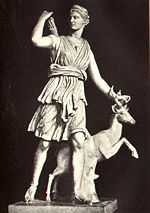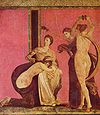Diana (mythology)
| Diana | |
 The Diana of Versailles |
|
| Goddess of the hunt | |
| Parents | Jupiter and Latona |
|---|---|
| Siblings | Apollo |
|
Ancient Roman Religion |
|
| Main doctrines | |
| Polytheism & Numen Mythology Imperial Cult · Festivals |
|
| Practices | |
|
Temples · Funerals |
|
|
Ceres · Diana · Juno |
|
| Texts | |
| Sibylline Books · Sibylline oracles Aeneid · Metamorphoses The Golden Ass |
|
| See also: | |
| Persecution · Nova Roma Greek polytheism |
In Roman mythology, Diana was the goddess of the hunt, being associated with wild animals and woodland, and also of the moon. In literature she was the equivalent of the Greek goddess Artemis, though in cult beliefs she was Italic, not Greek, in origin. Diana was worshipped in ancient Roman religion and is currently revered in the religions of Religio Romana Neopaganism and Stregheria.
Along with her main attributes, Diana was an emblem of chastity. Oak groves were especially sacred to her. According to mythology, Diana was born with her twin brother Apollo on the island of Delos, daughter of Jupiter and Latona. Diana made up a trinity with two other Roman deities: Egeria the water nymph, her servant and assistant midwife; and Virbius, the woodland god.
Contents |
Etymology
In her etymology, "Diana" is simply :"the Maiden Goddess", with a Greek parallel in the name — though not the cult practice — of Dione at Dodona. She was goddess of fertility and quick to anger.
Worship

Diana was initially just the hunting goddess, associated with wild animals and woodlands. She also later became a moon goddess, supplanting Luna.
Diana was worshipped at a festival on August 13,[1] when King Servius Tullius, himself born a slave, dedicated her shrine on the Aventine Hill in the mid-sixth century BCE. Being placed on the Aventine, and thus outside the pomerium, meant that Diana's cult essentially remained a 'foreign' one, like that of Bacchus; she was never officially 'transferred' to Rome as Juno was after the sack of Veii. It seems that her cult originated in Aricia,[2] where her priest, the Rex Nemorensis remained. There the simple open-air fane was held in common by the Latin tribes,[3] which Rome aspired to weld into a league and direct. Diana of the wood was soon thoroughly Hellenized,[4] "a process which culminated with the appearance of Diana beside Apollo in the first lectisternium at Rome".[5] Diana was regarded with great reverence by lower-class citizens and slaves; slaves could receive asylum in her temples.
Though some Roman patrons ordered marble replicas of the specifically Anatolian "Diana" of Ephesus, where the Temple of Artemis stood, Diana was usually depicted for educated Romans in her Greek guise. If she is accompanied by a deer, as in the Diana of Versailles (illustration, above right) this is because Diana was the patroness of hunting. The deer may also offer a covert reference to the myth of Acteon (or Actaeon), who saw her bathing naked. Diana transformed Acteon into a stag and set his own hunting dogs to kill him.
Worship of Diana is mentioned in the Bible. In Acts of the Apostles, Ephesian metalsmiths who felt threatened by Saint Paul’s preaching of Christianity, jealously rioted in her defense, shouting “Great is Diana of the Ephesians!” (Acts 19:28, New English Bible).
Legacy

In religion
Diana's cult has been related in Early Modern Europe to the cult of Nicevenn (aka Dame Habond, Perchta, Herodiana, etc.). She was related to myths of a female Wild Hunt, close to the Benandantis' struggles against evil witches.
Diana remains an important figure in some modern mythologies. Those who believe that prehistoric peoples lived in matriarchal societies consider Diana to have originated in a mother goddess worshiped at that time.
- Wicca
Today there is a branch of Wicca named for her, which is characterized by an exclusive focus on the feminine aspect of the Divine.
- Stregheria
In Italy the old religion of Stregheria embraced goddess Diana as Queen of the Witches; witches being the wise women healers of the time. Goddess Diana created the world of her own being having in herself the seeds of all creation yet to come. It is said that out of herself she divided into the darkness and the light, keeping for herself the darkness of creation and creating her brother Apollo, the light. Goddess Diana loved and ruled with her brother Apollo, the god of the Sun.
As time went on, the Earth was created and Diana descended to Earth, as did her brother Apollo. Diana taught magic and witches were born. One night using witchcraft in the form of a cat, His most beloved animal, Diana tricked Apollo. She gained entrance to His chamber where She seduced Him. From this union a daughter was born, the goddess Aradia.
Some people see Diana Nemorensis as a separate person or goddess, but she is the same Roman goddess, with different stories from different points of view, the strega and the Romans had different stories.
In the arts
Since the Renaissance the mythic Diana has often been expressed in the visual and dramatic arts, including the opera L'arbore di Diana. In the sixteenth century, Diana's image figured prominently at the Château de Fontainebleau, in deference to Diane de Poitiers, mistress of two French kings. At Versailles she was incorporated into the Olympian iconography with which Louis XIV, the Apollo-like "Sun King" liked to surround himself.
There are also references to her in common literature. In Shakespeare's play, Romeo and Juliet, many references are made to Diana. Rosaline, a beautiful woman who has sworn to chastity, is said to have "Dian's wit". Later on in the play, Romeo says, "It is the East, and Juliet is the sun. Arise fair sun, and kill the envious moon." He is saying that Juliet is better than Diana and Rosaline for not swearing chastity. Diana is also a character in the 1876 Leo Delibe ballet 'Sylvia'. The plot deals with Sylvia, one of Diana's nymphs and sworn to chastity and Diana's assault on Sylvia's affections for the shepherd Amyntas.
In Jean Cocteau's 1946 film La Belle et la Bête it is Diana's power which has transformed and imprisoned the beast.
In literature
In comic book lore, the character of Wonder Woman who hails from Paradise Island which is rich in Greek mythology is written to be a descendant of the Gods, and named after the moon goddess, Diana
Diana, like many aspects of mythology, is depicted in the comic books Asterix. In the Roman temples, many times a statue of Diana can be seen in the background, depicted as a well rounded lady, usually sitting on a stag, who appears to be suffering.
In language
Both the Romanian word for "fairy", zânǎ[6] and the Asturian word for "water nymph", xana, seem to come from the name of Diana.

Other
In the funeral oration of Diana, Princess of Wales in 1997, her brother drew an ironic analogy between the ancient goddess of hunting and his sister - 'the most hunted person of the modern age'.
Notes
- ↑ The date coincides with the founding dates celebrated ar Aricium. Arthur E. Gordon, "On the Origin of Diana", Transactions and Proceedings of the American Philological Association 63 (1932, pp. 177-192) p 178.
- ↑ Her cult at Aricia was first attested in Latin literature by Cato the Elder, in a surviving quote by the late grammarian Priscian. Supposed Greek origins for the Aricia cult are strictly a literary topos. (Gordon 1932:178 note, and p. 181).
- ↑ commune Latinorum Dianae temple in Varro, Lingua Latina v.43; the cult there was of antique religione in Pliny's Natural History, xliv. 91, 242.
- ↑ The Potnia Theron aspect of Hellenic Artemis is represented in Capua and Signia, Greek cities of Magna Graecia, in the fifth century BCE.
- ↑ Gordon 1932:179.
- ↑ zână in DEX'98 and NODEX.
See also
- Diana Nemorensis
- Wild Hunt
External links
|
|||||||||||||||||||
